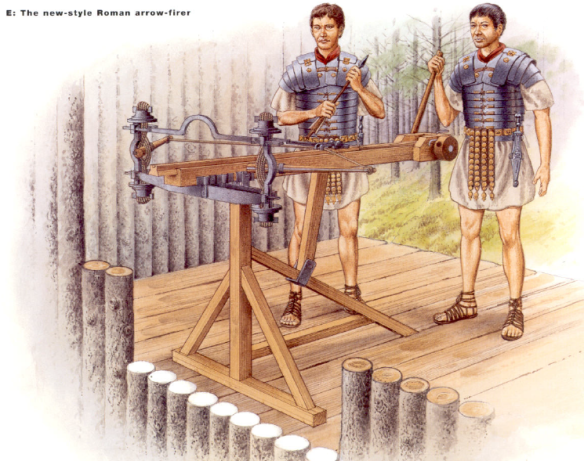The practical Romans had only to make one or two refinements to Greek models and then put the machines to use. Artillery machines came in several different sizes, the determining factor being the size of the bolt to be shot or the weight of the stone to be projected. Vitruvius explains how this affects the proportions in manufacturing catapultae and ballistae, including a ready-reckoner relating weight of the stones to the proportions of the machine “so that those who are not skill ed in geometry may be prep a red beforehand and not be delayed in thinking the matter through at a time of danger” (De Architectura 10. 10.-11). The bolts or stones were placed in the central channel, and the bowstring was pulled back onto the trigger, the only difference being that the bowstrings for stone-throwing machines were broader, approximating to a sling that encompassed the stone ball, with a loop at the back for the trigger.
The fragments of artillery engines that have been found on archaeological sites are useful for the reconstruction of the machines, the study of which began with German artillery officers such as Schramm whose work (1918) has been updated by Baatz (1980). Fully functional modern versions of artillery piece s are now operated by several reenactment societies, with frighteningly dangerous results. The metal fittings of a stone-throwing ballista were found at Hatra in Mesopotamia, which fell to the Persians in the third century ad, and a fourth-century bolt-shooting machine was found at Orsova in Romania, marking a transition from wooden casing to metal construction (Baatz, 1978). This was an improvement on timber, which does not perform well in hot climates and is subject to warping (Landels, 2000). Bolts from Roman artillery are more commonly found than the parts of the machines that fired them. They varied little throughout the Roman Empire, nor did they change with the passage of time. They had pyramid-shaped iron heads and timber shafts, with fletchings made not from feathers but from thin pieces of wood (Ammianus 24.4.16). The vanes were placed so that one-half of the shaft was smooth, allowing it to slot into the groove of the machine. These bolts could pass straight through armor. During a siege in the later Roman Empire, a Goth was pinned to a tree by a bolt that had passed through his cuirass and his body and had then embedded itself for half its length in the tree trunk (Southern and Dixon, 1996).
The portable artillery machines called carroballistae, drawn by mule cart, are attested on Trajan’s Column and by Vegetius (Epitoma Rei Militaris 2.25). The Romans had batteries of them, and they were used like modern machine guns to pin down the enemy (Landels, 2000), just as the larger machines were used in sieges to keep defenders off the walls. Tacitus relates how with one machine Vitellius’s troops were massacring those of Galba at the battle of Cremona in the civil war of ad 69, and some of Galba’s men crept up to put the machine out of action by cutting the cords of the springs. Trajan’s troops in the Danube Wars took replaceable springs so that the machines would not be out of action for lack of them (Landels, 2000).
In the later Empire artillery was used to defend as well as besiege cities, and special platforms were built for machines on the battlements. In ad 225 the cohors I Fida Vardullorum constructed a ballistarium at the fort of High Rochester in Northumberland in northern England (RIB 1280). Marsden (1969) thought that, despite the name ballistarium, the actual machine would have been an onager, since the platform was strong enough to support such a heavy piece, but these machines were more useful in besieging a city or fort, or defending a place that had been invested, and the stones fired from them had the power to damage walls and shatter siege towers. At High Rochester it may not have been necessary to shoot down siege towers, but to aim at humans, and the inscription may mean what it says.
